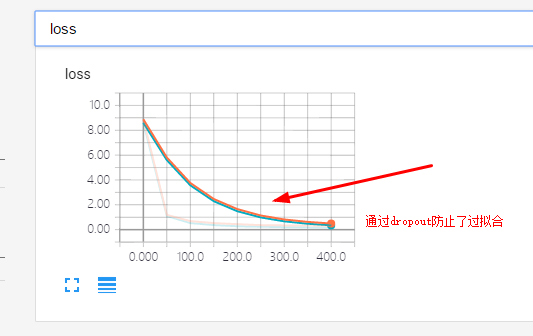1.9TF的过拟合-dropout
不带dropout程序并通过tensorboard查看loss的图像
"""
Please note, this code is only for python 3+. If you are using python 2+, please modify the code accordingly.
"""
from __future__ import print_function
import tensorflow as tf
from sklearn.datasets import load_digits
from sklearn.cross_validation import train_test_split
from sklearn.preprocessing import LabelBinarizer # load data
digits = load_digits()
X = digits.data
y = digits.target
y = LabelBinarizer().fit_transform(y)
X_train, X_test, y_train, y_test = train_test_split(X, y, test_size=.3) def add_layer(inputs, in_size, out_size, layer_name, activation_function=None, ):
# add one more layer and return the output of this layer
Weights = tf.Variable(tf.random_normal([in_size, out_size]))
biases = tf.Variable(tf.zeros([1, out_size]) + 0.1, )
Wx_plus_b = tf.matmul(inputs, Weights) + biases
# here to dropout if activation_function is None:
outputs = Wx_plus_b
else:
outputs = activation_function(Wx_plus_b, )
tf.summary.histogram(layer_name + '/outputs', outputs)
return outputs # define placeholder for inputs to network xs = tf.placeholder(tf.float32, [None, 64]) # 8x8
ys = tf.placeholder(tf.float32, [None, 10]) # add output layer
l1 = add_layer(xs, 64, 50, 'l1', activation_function=tf.nn.tanh)
prediction = add_layer(l1, 50, 10, 'l2', activation_function=tf.nn.softmax) # the loss between prediction and real data
cross_entropy = tf.reduce_mean(-tf.reduce_sum(ys * tf.log(prediction),
reduction_indices=[1])) # loss
tf.summary.scalar('loss', cross_entropy)
train_step = tf.train.GradientDescentOptimizer(0.5).minimize(cross_entropy) sess = tf.Session()
merged = tf.summary.merge_all()
# summary writer goes in here
train_writer = tf.summary.FileWriter("logs/train", sess.graph)
test_writer = tf.summary.FileWriter("logs/test", sess.graph) # tf.initialize_all_variables() no long valid from
# 2017-03-02 if using tensorflow >= 0.12
if int((tf.__version__).split('.')[1]) < 12 and int((tf.__version__).split('.')[0]) < 1:
init = tf.initialize_all_variables()
else:
init = tf.global_variables_initializer()
sess.run(init) for i in range(500):
# here to determine the keeping probability
sess.run(train_step, feed_dict={xs: X_train, ys: y_train})
if i % 50 == 0:
# record loss
train_result = sess.run(merged, feed_dict={xs: X_train, ys: y_train})
test_result = sess.run(merged, feed_dict={xs: X_test, ys: y_test})
train_writer.add_summary(train_result, i)
test_writer.add_summary(test_result, i)
执行完之后在执行目录之下有一个log目录生成了对应的tensorboard显示文件
使用 tensorboard --logdir="logs/" --port=8011 即可在浏览器访问
带有dropout的程序并通过tensoeboard生成loss图像观察
"""
Please note, this code is only for python 3+. If you are using python 2+, please modify the code accordingly.
"""
from __future__ import print_function
import tensorflow as tf
from sklearn.datasets import load_digits
from sklearn.cross_validation import train_test_split
from sklearn.preprocessing import LabelBinarizer # load data
digits = load_digits()
X = digits.data
y = digits.target
y = LabelBinarizer().fit_transform(y)
X_train, X_test, y_train, y_test = train_test_split(X, y, test_size=.3) def add_layer(inputs, in_size, out_size, layer_name, activation_function=None, ):
# add one more layer and return the output of this layer
Weights = tf.Variable(tf.random_normal([in_size, out_size]))
biases = tf.Variable(tf.zeros([1, out_size]) + 0.1, )
Wx_plus_b = tf.matmul(inputs, Weights) + biases
# here to dropout
Wx_plus_b = tf.nn.dropout(Wx_plus_b, keep_prob)
if activation_function is None:
outputs = Wx_plus_b
else:
outputs = activation_function(Wx_plus_b, )
tf.summary.histogram(layer_name + '/outputs', outputs)
return outputs # define placeholder for inputs to network
keep_prob = tf.placeholder(tf.float32) #dropout
xs = tf.placeholder(tf.float32, [None, 64]) # 8x8
ys = tf.placeholder(tf.float32, [None, 10]) # add output layer
l1 = add_layer(xs, 64, 50, 'l1', activation_function=tf.nn.tanh)
prediction = add_layer(l1, 50, 10, 'l2', activation_function=tf.nn.softmax) # the loss between prediction and real data
cross_entropy = tf.reduce_mean(-tf.reduce_sum(ys * tf.log(prediction),
reduction_indices=[1])) # loss
tf.summary.scalar('loss', cross_entropy)
train_step = tf.train.GradientDescentOptimizer(0.5).minimize(cross_entropy) sess = tf.Session()
merged = tf.summary.merge_all()
# summary writer goes in here
train_writer = tf.summary.FileWriter("logs/train", sess.graph)
test_writer = tf.summary.FileWriter("logs/test", sess.graph) # tf.initialize_all_variables() no long valid from
# 2017-03-02 if using tensorflow >= 0.12
if int((tf.__version__).split('.')[1]) < 12 and int((tf.__version__).split('.')[0]) < 1:
init = tf.initialize_all_variables()
else:
init = tf.global_variables_initializer()
sess.run(init) for i in range(500):
# here to determine the keeping probability
sess.run(train_step, feed_dict={xs: X_train, ys: y_train, keep_prob: 0.5})
if i % 50 == 0:
# record loss
train_result = sess.run(merged, feed_dict={xs: X_train, ys: y_train, keep_prob: 1})
test_result = sess.run(merged, feed_dict={xs: X_test, ys: y_test, keep_prob: 1})
train_writer.add_summary(train_result, i)
test_writer.add_summary(test_result, i)
图片显示:

1.9TF的过拟合-dropout的更多相关文章
- 理解dropout——本质是通过阻止特征检测器的共同作用来防止过拟合 Dropout是指在模型训练时随机让网络某些隐含层节点的权重不工作,不工作的那些节点可以暂时认为不是网络结构的一部分,但是它的权重得保留下来(只是暂时不更新而已),因为下次样本输入时它可能又得工作了
理解dropout from:http://blog.csdn.net/stdcoutzyx/article/details/49022443 http://www.cnblogs.com/torna ...
- [CS231n-CNN] Training Neural Networks Part 1 : parameter updates, ensembles, dropout
课程主页:http://cs231n.stanford.edu/ ___________________________________________________________________ ...
- [DeeplearningAI笔记]改善深层神经网络1.4_1.8深度学习实用层面_正则化Regularization与改善过拟合
觉得有用的话,欢迎一起讨论相互学习~Follow Me 1.4 正则化(regularization) 如果你的神经网络出现了过拟合(训练集与验证集得到的结果方差较大),最先想到的方法就是正则化(re ...
- Dropout原理分析
工作流程 dropout用于解决过拟合,通过在每个batch中删除某些节点(cell)进行训练,从而提高模型训练的效果. 通过随机化一个伯努利分布,然后于输入y进行乘法,将对应位置的cell置零.然后 ...
- Python机器学习笔记:不得不了解的机器学习面试知识点(1)
机器学习岗位的面试中通常会对一些常见的机器学习算法和思想进行提问,在平时的学习过程中可能对算法的理论,注意点,区别会有一定的认识,但是这些知识可能不系统,在回答的时候未必能在短时间内答出自己的认识,因 ...
- 深度学习(六)keras常用函数学习
原文作者:aircraft 原文链接:https://www.cnblogs.com/DOMLX/p/9769301.html Keras是什么? Keras:基于Theano和TensorFlow的 ...
- 截图:【炼数成金】深度学习框架Tensorflow学习与应用
创建图.启动图 Shift+Tab Tab 变量介绍: F etch Feed 简单的模型构造 :线性回归 MNIST数据集 Softmax函数 非线性回归神经网络 MINIST数据集分类器简单版 ...
- Tensorflow 之模型内容可视化
TensorFlow模型保存和提取方法 1. tensorflow实现 卷积神经网络CNN:Tensorflow实现(以及对卷积特征的可视化) # 卷积网络的训练数据为MNIST(28*28灰度单色图 ...
- CNN卷积神经网络的构建
1.卷积神经网络由输入层,卷积层,激活函数,池化层,全连接层组成. input(输入层)--conv(卷积层)--relu(激活函数)--pool(池化层)--fc(全连接层) 2.卷积层: 主要用来 ...
随机推荐
- python--模块--10
原创博文,转载请标明出处--周学伟http://www.cnblogs.com/zxouxuewei/ Python 模块 Python 模块(Module),是一个 Python 文件,以 .py ...
- InnoDB锁问题 & DB事务隔离级别
<参考:http://www.cnblogs.com/jack204/archive/2012/06/09/2542940.html>InnoDB行锁实现方式InnoDB行锁是通过给索引上 ...
- Java按钮控件数组实现计算器界面
编写程序,通过按钮数组来管理界面中的所有按钮控件,从而使用最少的代码实现模拟的计算器界面. 思路如下: 创建一个类,通过extends使其继承窗体类JFrame: 创建一个JFrame对象,使用JFr ...
- 8 -- 深入使用Spring -- 4...2 使用AspectJ实现AOP
8.4.2 使用AspectJ实现AOP AspectJ是一个基于Java语言的AOP框架.Spring 4.0 的AOP对AspectJ很好的集成. AspectJ是Java 语言的一个AOP实现, ...
- 使用pull方式解析xml文件示例:
网上的示例太多,基本类似,个人在此做个简单的总结: 1.首先在工程的asserts目录下建一个book.xml文件: <?xml version="1.0" encoding ...
- C#中的垃圾回收机制与delegate
在DeepStream的C#版本调试过程中,发现了一个问题,运行一段时间后,大概每次内存到16M(Debug模式)就会异常 错误“System.NullReferenceException:未将对象引 ...
- N76E003的学习之路(ADC简单小例程篇)
N76E003内嵌12位逐次逼近寄存器型(SAR)的模拟数字转换器(ADC).模数转换模块负责将管脚上的模拟信号转换为12位二进制数据.N76E003支持8通道单端输入模式.内部带隙电压(band-g ...
- Delphi 10 Seattle 小票打印控件TQ_Printer
TQ_Printrer控件,是一个为方便需要控制打印命令而设计的跨平台专用控件,已包含标准ESC/POS打印控制的基本指令在内(这些基本指令已能很好的满足多数项目使用). TQ_Printrer控件让 ...
- scanf printf sprintf fprintf
都是C语言中的函数,但C++保留了这些函数,在头文件iostream中声明了. 1 scanf(格式控制,输出列表) printf (格式控制,输出列表) 举例: #include <iostr ...
- 原生js--http请求
1.终止请求和超时 终止请求XMLHttpRequest对象提供abort方法,调用该方法时触发abort事件 XHR2提供了timeout属性,当超时发生时触发timeout事件.但浏览器尚不支持自 ...
